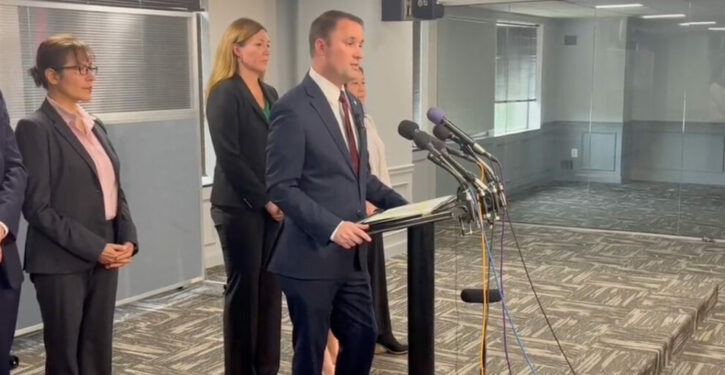
On February 27, Virginia Attorney General Jason Miyares sent a letter to Virginia state legislators about a Democratic proposal to allow some violent offenders to receive sentence reductions they previously were excluded from.
Miyares asked legislators to prevent the proposal, passed by the House of Delegates on February 22, from going into effect, by adopting Gov. Glenn Youngkin‘s proposed budget item 390(R)(2).
“Cutting sentences for violent crime, especially in cases identified as a high risk for recidivism, is having a detrimental impact on public safety throughout Virginia,” Miyares wrote in the letter. “Aggressive sentence reductions for violent criminals and those with high risk for recidivism disregards past and future victims. Allowing such a practice is not justice, and it’s not safe.”
The Augusta Free Press reports:
Virginia’s earned sentence credit program was expanded in 2020 to permit sentence reductions for qualifying inmates. Evidence now shows that since 2020, the enhanced earned sentence credits program poses a danger to Virginians and to public safety stemming from the risk of recidivism by violent offenders. The Attorney General’s brief breaks down recidivism data from the legislation’s first full year, showing that:
- Inmates released under the enhanced earned sentence credits have a significantly higher recidivism rate than those under the previous program.
- In 2023, 2,725 enhanced earned sentence credit offenders were rearrested for new crimes, including three capital murders, eight first degree murders, four second degree murders, 48 abductions, and 28 rapes and other felony sexual assaults.
- 1,334 offenders released on enhanced earned sentence credits in 2023 have been convicted of a new crime or probation violation
- The EESC system forced the early release of 1,598 offenders categorized as a high risk for violent recidivism and 2,369 offenders categorized as a high risk for general recidivism.
- Over 50 percent of the offenders released through EESC and re-convicted had a high or medium risk of general recidivism and close to 50 percent also had a high or medium risk of violent recidivism.
The current biennial budget temporarily prohibits the application of enhanced sentence credits to inmates who were convicted of a mix of violent and nonviolent offenses in the same act or transaction. However, the temporary prohibition expires July 1, 2024, and without further action, 8,300 offenders would qualify to have their sentences reduced and 99.6 percent have been convicted of a violent felony according to Department of Corrections data.
For taxpayers, the changes will cost at least $7.3 million annually, as the Department of Corrections evaluates the personnel required to supervise the continued influx of new offenders on probation. Technology-related expenses have already cost taxpayers $1.3 million, and continued changes to the legislation will incur additional expenses.
Even after the current budget expires, inmates now serving sentences for violent offenses only (as opposed to a mix of violent and nonviolent offenses) will not qualify for expanded sentence reductions on their sentences for those violent offenses, because they would still be excluded by a Virginia Code section. But violent offenders will qualify for expanded sentence reductions on their sentences for non-violent offenses, if the temporary prohibition contained in the current budget is not extended.
Miyares adds, “I urge the General Assembly to consider these cost concerns and recent recidivism data … regarding the earned sentence credit program this session.”
Recidivism was higher for the inmates covered by the expanded (enhanced) sentence credits than the regular sentence credits. The recidivism rate for inmates released in Fiscal Year 2023 was 28.27% for inmates benefiting from the expanded sentence credits compared to 20.38% for those not eligible for them.
If expanded sentence credits were extended to the additional class of inmates proposed by Democrats — those convicted of a mix of violent and nonviolent offenses in the same act or transaction — their recidivism rate would likely be higher still. That’s because such inmates are more likely to be repeat offenders with long rap sheets than those currently covered by enhanced sentence credits, and have already shown a propensity to commit both violent and non-violent crimes.
Recidivism can rise when sentences are reduced. For example, “Recidivism among 16-year-olds went up” a lot when the age for being prosecuted in adult court was raised in New York, notes criminology professor Peter Moskos.
Of the inmates covered by the Democrats’ proposal, “Approximately a third of these 8,300 violent offenders—2,752—are serving their second or third term in state prison. 694 of the 8,300, or 8.3%, are serving their fourth or subsequent state prison term,” the Attorney General says. “It is well-known that two to five percent of offenders commit over 50% of all crime, and this EESC expansion is likely to benefit those two to five percent of repeat offenders.”
Releasing career criminals early harms law-abiding citizens. A 1998 study in the Journal of Quantitative Criminology estimated that there were “$165,000 in victim costs per year of a criminal’s career” for a typical “career criminal.” A 2014 study in the American Economic Journal found that early releases of prison inmates raised the crime rate. Releasing criminals early makes it harder to deter crimes. A National Bureau of Economic Research study found that longer sentences for repeat offenders in California deterred many crimes from being committed. When El Salvador increased its incarceration rate, its murder rate fell by more than 90%.
The recidivism rates cited by the Attorney General only covered inmates released in Fiscal Year 2023 — who have been out of prison for only a brief period — and thus were not all that high (the law expanding sentence credits only went into effect in July 2022). But many criminals take longer to reoffend than a year, so recidivism rates tend to rise over time, and become larger when recidivism is measured over an 8-year or 10-year period. When the U.S. Sentencing Commission recently looked at reoffense rates over a longer 8-year period, it found that violent offenders returned to crime after being released, at a 63.8% rate. Nationally, 81.9% of all state prisoners released in 2008 were subsequently arrested within a decade, including 74.5% of those 40 or older at the time of their release — although that data was not specific to Virginia, which historically had a recidivism rate below the national average. (See Bureau of Justice Statistics, Recidivism of Prisoners in 24 States Released in 2008: A 10-Year Follow-Up Period (2008-2018), pg. 4, Table 4).



